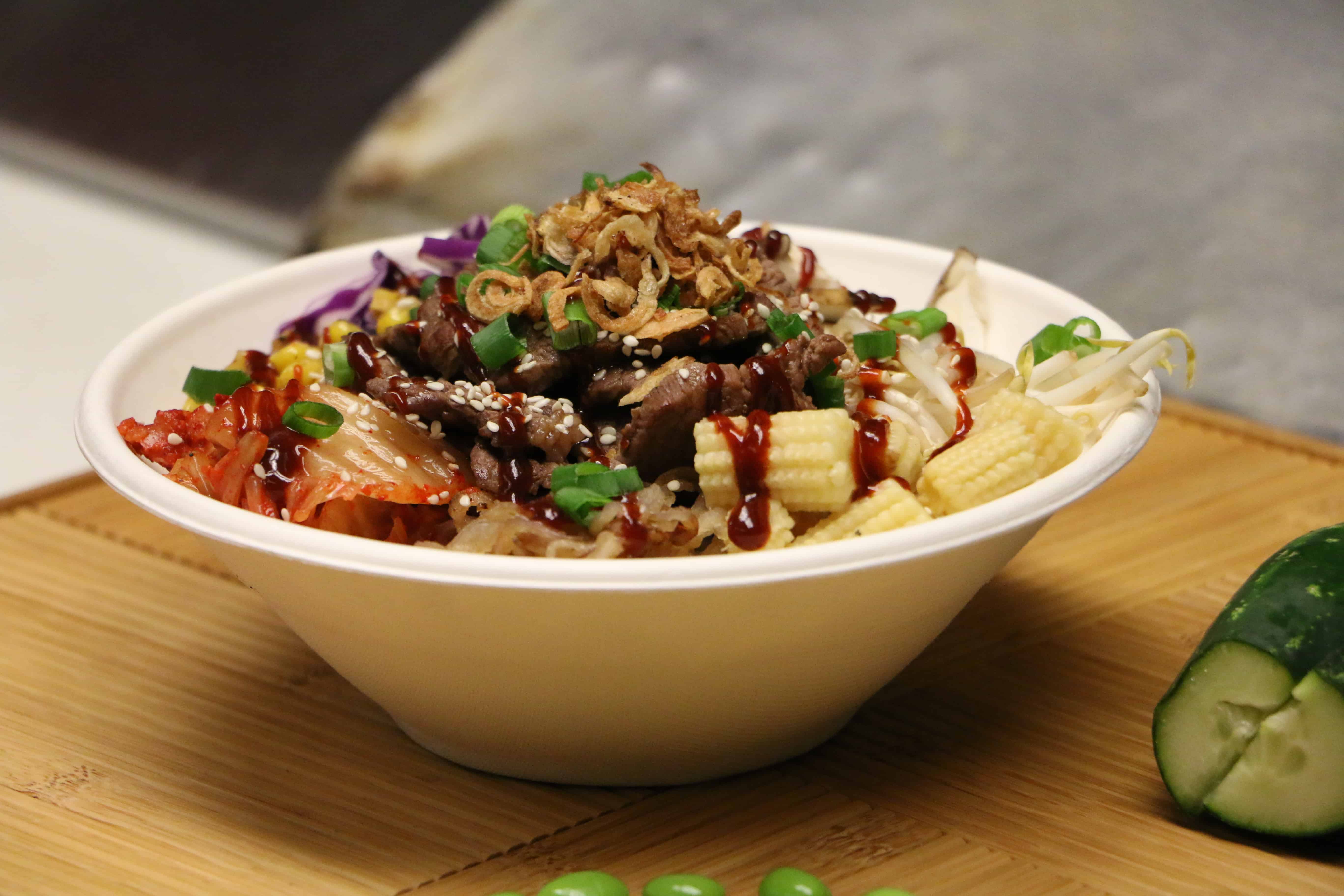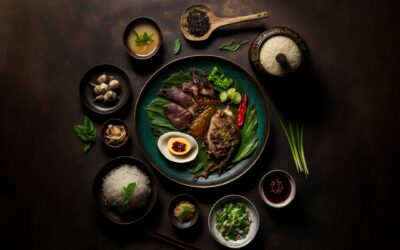Bibimbap Sauce: What is it and What are the Different Ways to Make
What is bibimbap?
Asian cuisine is known for its broad range of flavors and textures. From sweet to salty and spicy, Asians have certainly mastered the art of cooking. There are many countries on this continent that stand out for their creative and exotic food. The cultures represented in Asia frequently use different ingredients to prepare dishes that can represent the essence of each one of them.
In Korea, cooking is an important part of the family’s traditions. Their recipes have passed from generation to generation, where tradition and flavors remain. This means that younger family members are responsible for keeping the tradition alive and let the world know about the diversity of their gastronomy. It’s no different with Bibimbap, one of Asia’s most famous dishes. This delicacy is prepared in most regions, especially in the center.
The most popular dish using bibimbap is a bowl of rice topped with several vegetables and meat. It’s then served with traditional bibimbap sauce or gochujang sauce.
The meaning of “bibimbap” comes from two words, bibim which means mixing, and bap means rice. When it’s time to serve, the bibimbap is delicately arranged in a bowl and the mixing happens at the table when it’s time to eat it.
This kind of dish encourages families to gather and share a good time together while eating good homemade bibimbap. The Asian culture highly regards their elders and encourages all to participate in their preparations as it strengthens family ties and fosters a sense of belonging.
The origin of bibimbap dates back to the 19th century where experts believe that bibimbap was a traditional dish for farmers during the harvest. Since it could be easily made in large quantities it was used to feed many farmhands and their families. Other theories say that it originates in the Jesa ancestral rites, wherein offerings of food made as a gift to ancestors would be assembled in a bowl before eating.


What is Bibimbap Sauce?
If you have gone to a Korean restaurant you might be familiar with their intense and unique flavors. It’s no secret just how important sauces and dressing are for some of their tasty dishes.
In this case, bibimbap is a tasty and diverse dish that includes several layers of flavors and textures. This rice bowl is not complete without the bibimbap sauce. In fact, we’d say the sauce not only encompasses everything about Korean cuisine. It does have a slightly pungent, spicy, sweet, and salty flavor that will turn you into a Korean food lover.
Bibimbap sauce is prepared with several ingredients that provide a unique flavor in this classic Koren dish. It’s well-known for being one of the favorite comfort foods for most Koreans. While the dish may vary depending on who prepares it, the bibimbap sauce does change as it’s what brings all of the flavors of the dish together.
The ingredients to prepare a mind-blowing bibimbap sauce can vary but the most common are garlic, sesame oil, honey, sugar, rice vinegar, salt, and gochujang. It makes sense that these are some of the most commonly used ingredients in Korean cuisine. And anyone will tell you that what really makes bibimbap sauce stand out is the gochujang.
Bibimbap: Gochujang sauce as the star ingredient
In some dishes, it takes just one ingredient to make it incredible. This is the case for bibimbap. This extraordinary sauce is gochujang-based, but that raises the question: why is gochujang so important for this sauce? Let’s find out.
First of all, the gochujang is made of a fermented Korean chili paste. The chili paste uses fermented soybeans, red chili pepper flakes, glutinous rice, and salt. It’s predominantly spicy on its own so even when used in a small amount it adds a good amount of intensity to your dish. When mixed with other ingredients this sauce really brings out the flavors and enhances the overall taste of the dish.
To prepare traditional gochujang paste it’s necessary to wait at least six months for all the ingredients to be fermented. Once fermented the recipe comes together rather quickly and is an easy recipe to make. If you’re interested in creating your own gochujang paste at home. You will need:
- Gochugaru (Korean red pepper flakes)
- Water
- Honey
- Rice vinegar
- Red miso paste
- Salt
Using the gochugaru, water, miso paste, and honey, mix them in a small pot, and turn the heat to the medium. Keep stirring until the mixture starts to bubble and then turn the heat off.
Let it cool for about 15 minutes, until it reaches room temperature. Stir in the remaining ingredients and transfer the gochugaru paste into a jar and it’s ready to use in other preparations.
Four Different Bibimbap Sauces You Can Make
When a dish or sauce gains in popularity it’s inevitable that people will start creating their own version. This spin-off of the original recipe is useful as cooks adapt it to other dishes.
Variations that are more sweet, non-spicy, or extra spicy allow you to create the final dish that is to your liking. This has lead to a wide variety of bibimbap sauce recipes being handed down and then spread around the world.
The best part of making your own sauce is you can make it your own depending on your own personal taste.
As you get creative with the sauce, consider some of these alternative gochujang sauce recipes:
Garlic Gochujang Bibimbap Sauce
- Garlic
- Honey
- Sesame oil
- Water
- Gochujang paste
- Rice vinegar
- Salt
Put all the ingredients into a small bowl and mix well until it’s all incorporated. You can use more honey and sugar to get a sweeter flavor. Or for an extra kick add more gochujang paste for a spicy touch.
Meaty Gochujang Bibimbap Sauce
This meaty version of the gochujang bibimbap sauce is generally used for stir fry and made with ground meat. It’s a great condiment to have because it can really save your meal prep time and a smoky and meaty flavor to basic dishes.
It is also a popular dipping sauce for traditional Korean snacks like Korean candied sweet potatoes (goguma mattang), Korean egg toast, Chapssaltteok (red bean mochi), Cucumber boats with crab, and salad.
This sauce really helps enhance the natural flavor of the crab and gives that reddish look and smoky taste. Try it and you will not regret it!
As a bibimbap sauce, this sauce has a slightly different taste than the others. It also requires slightly more preparation than the rest of the sauces.
Its flavor and texture change a little when the meat is added. Traditionally fine layers of beef, pork, or chicken, as well as other ingredients. Honey could also be used to intensify the spiciness of the sauce depending on the quantity you use.
If you’re vegan or simply don’t like meat that much you can substitute the meat with some mushrooms too, it will have an amazing flavor as well.
Funky Doenjang Bibimbap Sauce
This bibimbap sauce may not be as popular as the original recipe but its taste will make you love it. The key ingredient for this funky version is doenjang (Korean miso paste). Slightly different but no less tasty!
This sauce combines well with vegetarian bibimbap and other vegan dishes. It’s also not as spicy. Its ingredients are:
- 1/2 cup doenjang (Korean soybean paste)
- 1/4 cup water
- 1/4 cup toasted sesame oil
- 1.5 Tbsp honey
- 2 Tbsp toasted sesame seeds
- 1 Tbsp minced garlic
Combine all ingredients in a bowl and mix them well. Serve with your bibimbap or your favorite veggies, sprouts, and mushrooms. Really whatever fits your fancy!
Kid-Friendly Soy Bibimbap Sauce
Who says bibimbap sauce is not for kids? With a couple of tweaks, this is a recipe all kids will love. It’s non-spicy but it still contains that particular flavor typical in the bibimbap.
This recipe is also perfect for all non-spicy lovers or for anyone who does not tolerate spicy food.
These are the ingredients:
- 1/2 cup soy sauce, regular
- 4 tsp sugar
- 4 tsp toasted sesame seeds
- 2 tsp toasted sesame oil
- 1 tsp minced garlic
Mix all ingredients and it’s ready. Enjoy!
How to Store Bibimbap Sauce
The way you choose to store your gochujang sauce for bibimbap will depend on the recipe you used to prepare. If you have made a traditional gochujang sauce, with fermented ingredients you can store it in a jar and leave it in your pantry. The more fermented it is, the less refrigeration it will need.
On the other hand, if it’s a fermented gochujang sauce with added meat or mushrooms, it will definitely need to be refrigerated.
However, if you prepared one of the recipes we mentioned earlier, those recipes were made with non-fermented ingredients. This means without refrigeration the sauce will go bad, making it inedible.
Another key point to keep in mind is that when you refrigerate any bibimbap sauce it tends to last longer. And when it’s not fermented the flavor intensifies and it tends to taste better.
Just like homemade sauces for bibimbap, jars of gochujang sauces from the store last around a year as long as it remains sealed. Once open, you’ll need to make sure to keep it stored in the refrigerator.
We encourage you to bring your family together and get familiar with Asian cuisine. There are so many different exciting flavors to try and you’re sure to find something everyone loves. Explore the many tastes that Asian cuisine has to offer by either using a recipe and cooking at home or by going to your favorite Asian restaurant.
Our Other Recent Posts
The Irresistible Allure of Beef Teriyaki: A Flavorful Journey in USA
If you’ve yet to experience the exquisite gastronomic delight that is beef teriyaki, you are missing out. This dish, popular in USA-based restaurants and beyond, is prepared using thinly sliced beef that has been marinated in a delectable blend of sweet and savory...
From Thailand to Vietnam: The Best Noodle Dishes in Southeast Asia
When it comes to Southeast Asian food, the one staple food you might think of is either rice or noodles. While rice is nice, you can’t overlook the hearty noodle. Fortunately, there are many different kinds of noodle dishes, from savory soups to stir fry, you’ll be...
Exploring Southeast Asian Street Food Culture
There’s no greater place on earth to experience authentic and exciting street food than Southeast Asia. From Malaysia to Thailand, from Vietnam to Cambodia the food and culture are lively and complex. Many of the dishes served in Southeast Asian countries have basic...
GET CATERING DETAILS
Drop Us a Line
Don’t be shy. Let us know if you have any questions!




